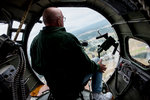
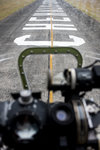
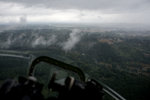
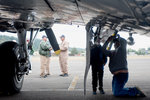
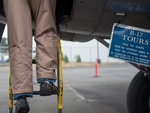
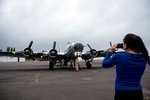
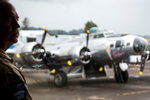
From her perch just below the cockpit, Betty Grable, the most famous pinup girl of her generation, stands in her most famous pose, looks over her shoulder and flashes a smile almost as arresting as the aircraft she’s printed on.
As part of a national tour, the Sentimental Journey, the most complete B-17G bomber in operation, is on display at the Chehalis-Centralia Airport, and one World War II fighter pilot got to take his first flight on Monday afternoon.
The Sentimental Journey rolled off the Douglas assembly line in 1944. Its introduction was too late for the battles of Europe so it spent its early days battling in the Pacific Theater. After the war it was used in sea rescue missions, then for nuclear testing and eventually as a firefighting aircraft until it was purchased by the Commemorative Air Force in the late ’70s.
“We consider these a national treasure, they belong to everyone,” said B-17 pilot Russ Gilmore.
At 97 years old, it was Harry Hokanson’s first time riding on a B-17, but not his first in a military aircraft. After graduating from Washington State University with a bachelor’s degree in forestry he joined the Navy and learned to fly.
“I was 22 when I got my wings. In the first few years you had to have a college degree,” he said. “... I’d have paid them to get to fly.”
Between 1940 and 1946, Hokanson helped the U.S. Armed Forces overwhelm the Japanese military in the Pacific Theater of WWII as a fighter pilot running combat and support missions. Stationed on a couple different aircraft carriers, he flew first in F4F Wildcat and its replacement, the 2,000 horsepower F6F Hellcat, as the military hopped from island to island.
The Boeing B-17, also known as “The Flying Fortress,” was an aircraft ahead of its time when it was publicly introduced in 1938. It was capable of flying more than 30,000 feet in the air, carry 4,800 pounds worth of bombs and 12 .50-caliber machine guns. When Seattle Times reporter Richard Williams viewed the first prototype in 1935 he coined its nickname “The Flying Fortress.”
During WWII the bulk of its service was done in Army bombing missions over Germany. The plane’s reputation grew to mythic proportions as soldiers shared tales of B-17s being heavily damaged in midair yet still being able to make it home. The planes were so heavily armed that the only way fighter pilots could attack them was by coming at them head on and trying to kill the pilot, said copilot Travis Majors.
Crawling up the small ladder and into the back of the plane is stepping into a relic of American military history; Army green makes the ammo crates and canvas strap seats stick out against the dull aluminum sheen of the B-17’s hulking ribbed core. The interior is too small to stand upright, so narrow people have to squeeze past one another.
Almost everywhere you look, a loaded .50-caliber machine gun points outside. According to Gilmore, this B-17 is the only one in operation with the chain turrets. The four propeller engines jostle everything as they rumble to life and a rich exhaust of antique motors wafts inside. At takeoff, the pilot hits the throttle, engines roar in unison and sound echos through the plane like a battle cry from the depths of hell.
Cables, tight like piano wire, symmetrically run the length of the fuselage ceiling, carrying pilot Gilmore’s commands from the controls to the wings, elevators and rudders outside.
“When you stand up don’t grab onto those,” said crew member Mike Mueller. “If you do, you’ll be controlling the plane and the pilot doesn’t like that very much.”
Walking through the Flying Fortress in midflight is no easy task. The floor rises up and shifts beneath feet, and you find yourself reaching for anything to catch yourself while still trying to avoid the cables overhead. The engines make it hard to hear yourself think, and the fumes from the exhaust permeate the plane.
Crews often went on missions of 10 hours or more, flying at elevation with temperatures sometimes at negative 50 degrees. Frostbite around the goggles, or on the hands, was a regular occurrence.
Most crewmen in a B-17 were barely out of their teens during the war. Typically the aircraft commander was 21 or 22 years old and the rest of his crew a year or two younger. Although he’s been flying planes since grade school and has been a commercial pilot for years, the reality of being so young in such a huge moment in world history was not lost on Major.
“There’s something special about the first flight to think of being 20 years old and having the odds of surviving every mission be less and less,” he said.
After the war the surplused B-17s were scrapped or melted down. Those that were left were occasionally sold to other governments or converted for fighting fires. But of the 12,731 that were built during the war, only eight airworthy B-17s remain in the U.S. and Europe combined.
Hokanson spent his flight in the radio seat looking out on the landscape. He never flew after the war ended and didn’t like the idea of changing history to fly a B-17 instead of a fighter plane.
“I wouldn’t want to be in one of these for very long. It’s a long ride to Germany,” he said.
The B-17 Sentimental Journey will be on display at the Chehalis-Centralia Airport until 8 a.m. on Tuesday, Sept 8, when it flies down to Tillamook, Oregon.